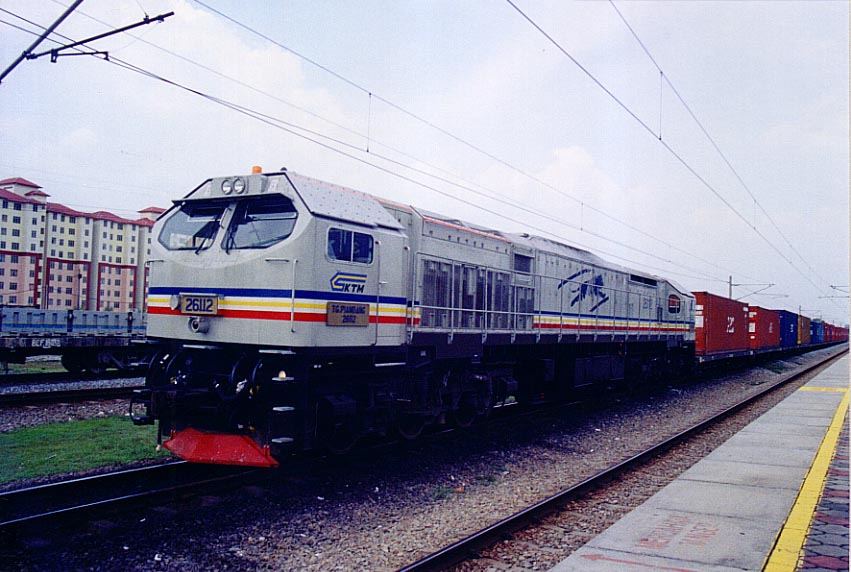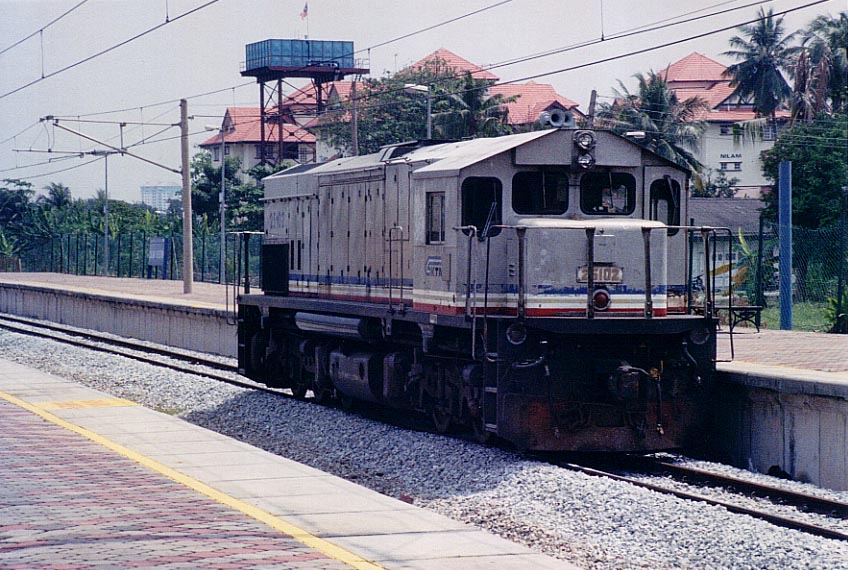Freight train in Malaysia are largely consist
of container trains. But there were some occasional fuel, chemical, and cement
train running around their network.
Freight train number is not like what it
used to be. Strong competition with trucks and motorcycles (!), had forced
Malaysian State railway to rationalize its freight operation.
As a result, the majority of freght train
in Malaysia are container trains. And all of them acted as a 'land bridge',
to transfer the containers between the ports. Mostly from southern port Johor
Bahru to Butterworth in far North.
Such effort did paid dividend. And now
they could modernized its freight operation, and able to purchase big locomotives
like the world famous 'Blue Tiger' locomotive.
 |
A small Alco YDM loco is working on
a short freight train through Bandar Tasik Selatan.
Bandar Tasik Selatan Station is a good
spot to take train photos, becauseof its safe and photogenic location.
And it is also a meeting point between KTM, Star and ERL lines.
|
 |
A close up view of YDM loco in Jalan
Kastam station.
It is a rather unique experience to be able to capture this image in
Malaysia, despite of tight restriction which forbid oridnary people to
walk on railway line and taking train pictures.
But in Jalan Kastam station, those things can be done easily, due to
relaxed security, and rather remote location.
|
 |
A further view of the same locomotive.
YDM locomotive was imported from India
several years ago. And they were surplus from Indian State Railway, when
the company decided to close or regauge their metre gauge network.
|
 |
A YDM loco is seen pulling a ballast
train in Serdang station.
YDM was built in India under licence
from Alco in united States. But when Alco went bankrupt in 1960s, the
Indian decided to continue to build their own Alcos.
|
 |
A Blue tiger locomotive sit idle at
Jalan Kastam Station with its engine off.
The Malaysian state Railway did actually
receive this locomotive from German government, as a payment for their
palm oil, which was exported to Germany from Malaysia.
Therefore, they didn't purchase this
locomotive. They just receive it!
|
 |
A close up look of Blue Tiger locomotive
in Jalan Kastam.
This view shows the Blue Tiger's massive
size, which is unique for a metre gauge line. Yet, this loco is also the
largest in South East Asia, despite some countries adopted a wider gauges.
|
 |
Blue Tiger is running light engine,
with a YDM loco on its back, through the famed Kuala Lumpur station.
Kuala Lumpur station is famous for
its Mosque-alike architecture, which blend Moorish and European style
architecture.
|
 |
Sentul Workshop viewed from the outside.
A derelict class 22 locomotive is squeezed
between a Blue Tiger locomotive and a Hyundai-built Electric multiple
unit.
|
 |
A pair of brand new Blue Tigers is
seen in Sentul Workshop. The locos had just been delivered at night before
this photo was taken. A group of German technicians are visible.
Sentul workshop is the largest locomotive
depo in Malaysia. It is used to maintain and repair all of Malaysian locomotives,
and it is also used as storage for disused locomotives.
|
 |
The Blue Tiger number 26112 is photographed
at Jalan Kastam station, having just finished its duty pulling a container
train from somewhere to Port Klang.
The apartement building in the background
gave impression as if this photo was taken in downtown area. But the truth
is, Jalan Kastam station is actually located on the outskirt of Kuala
Lumpur, and the station itself is very quiet when there were no freight
activities.
|
 |
A close up look of 26112 'Tanjung Piandang'.
|
 |
An interesting photoshot of Blue Tiger
while working on a short freight train, in Bandar Tasik Selatan station.
|
 |
A class 24 locomotive is seen pulling
a tanker train through Serdang Station.
Compared with YDM or Blue Tiger, nowaday
the Class 24 are rarely used on freight train, as they were normally used
on passenger trains.
|
 |
A Class 25 locomotive is resting at
Jalan Kastam station.
Although initially built for commuter
train, the platform no.1 in Jalan Kastam Station is rarely used for commuter
service. Instead it is used for locomotive stabling point.
|